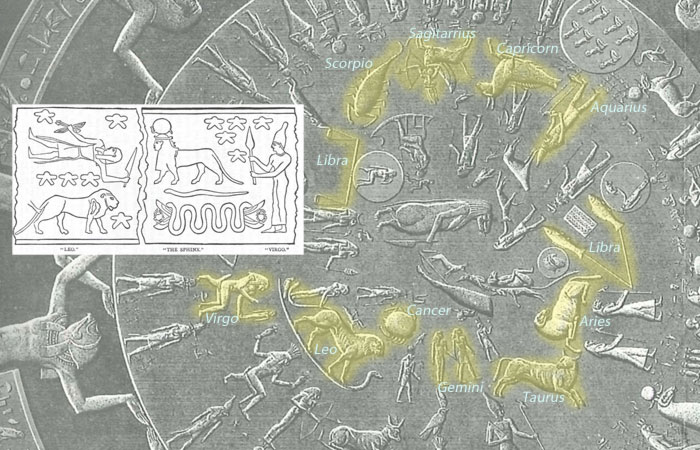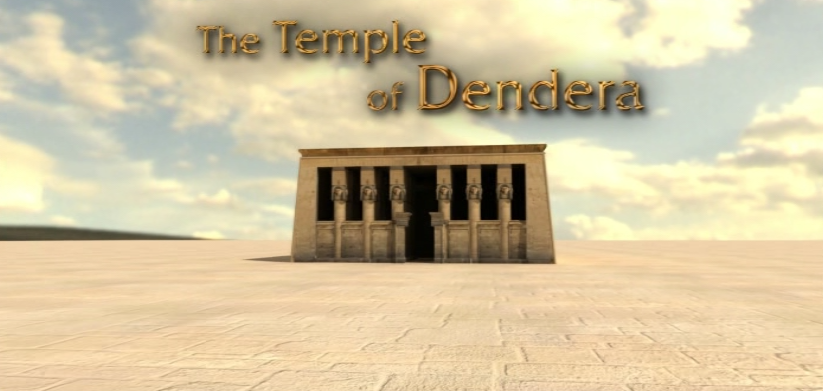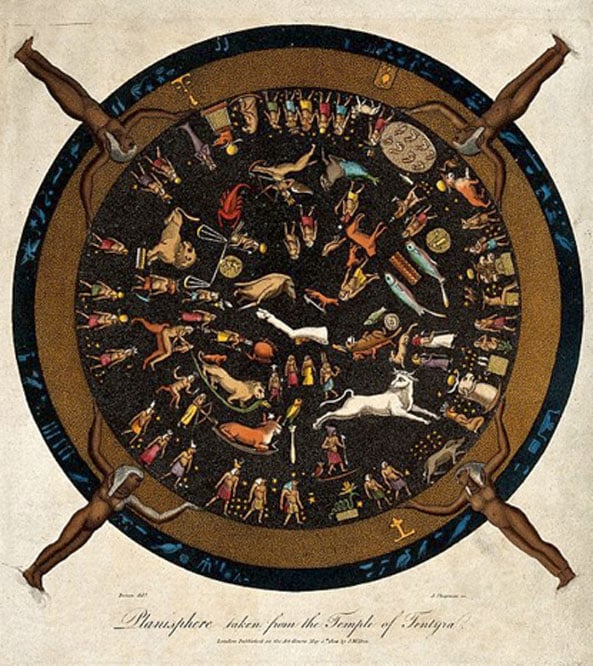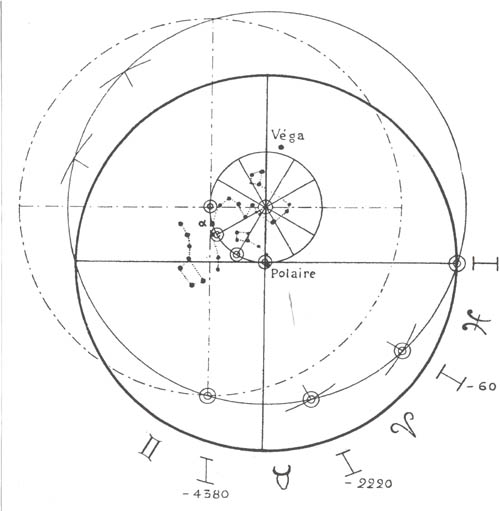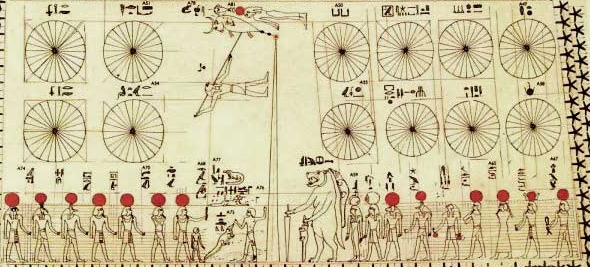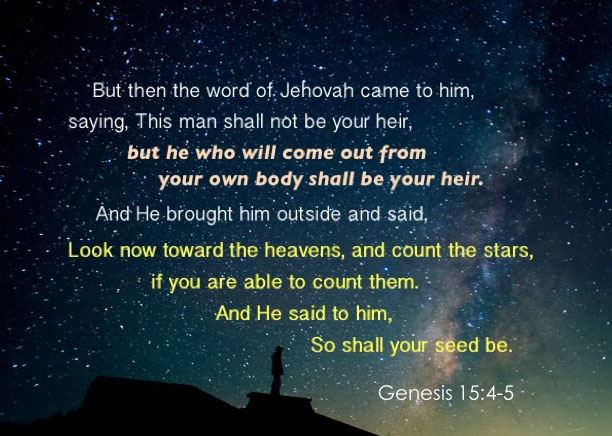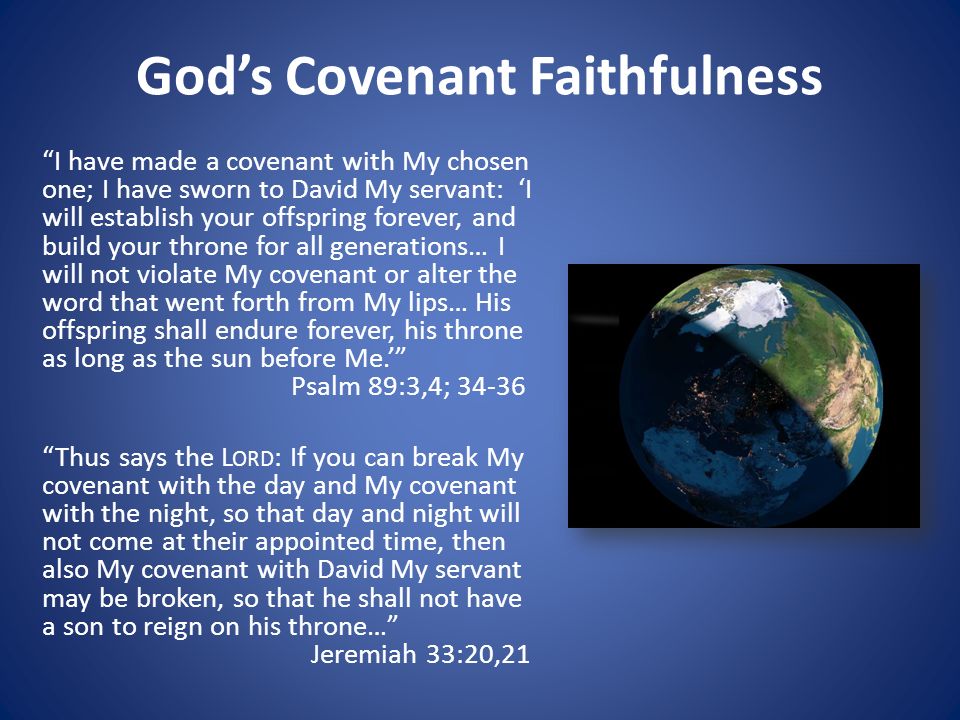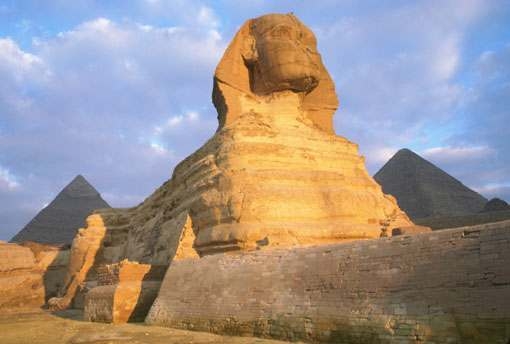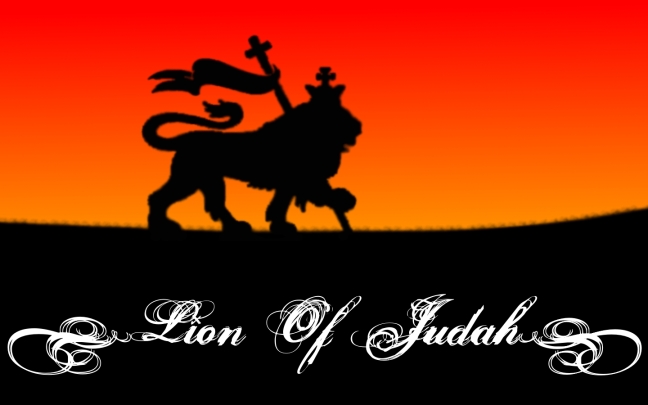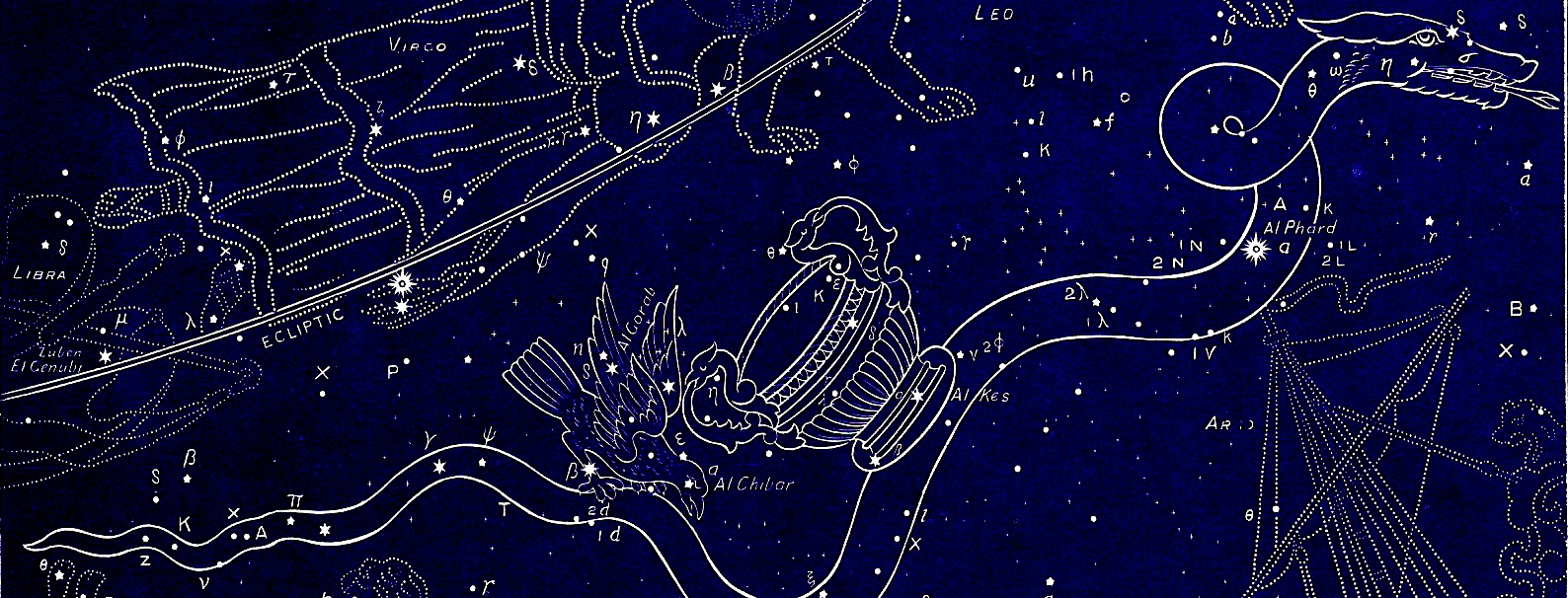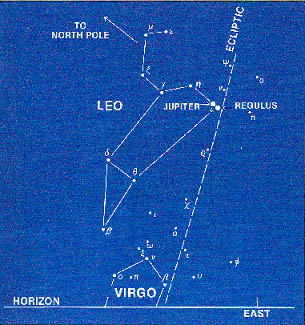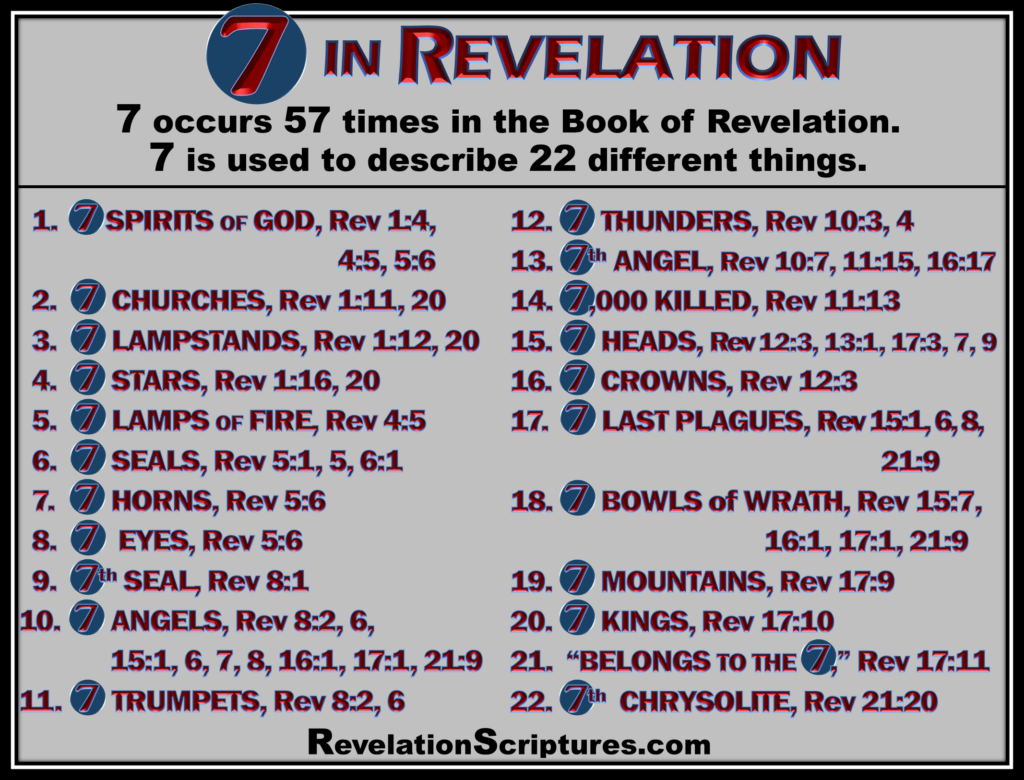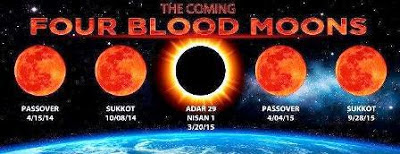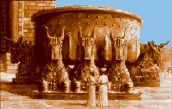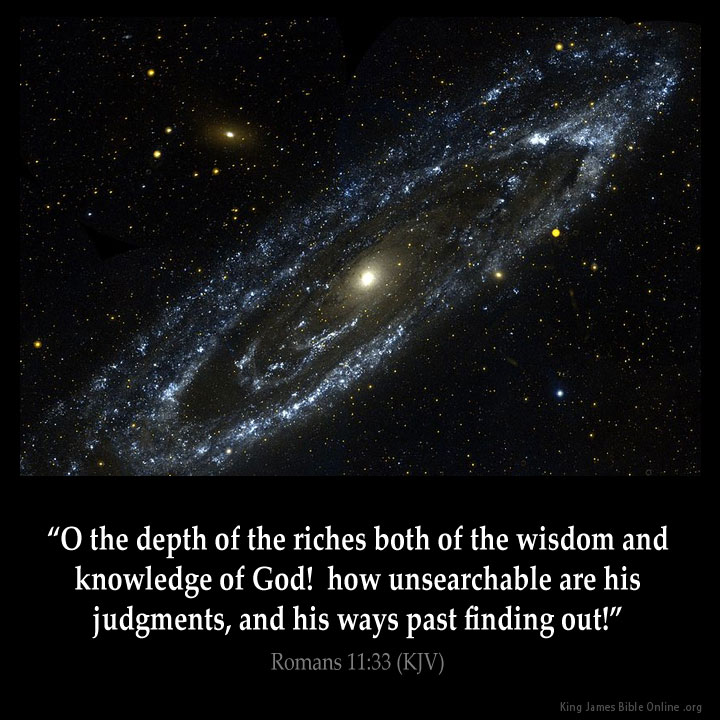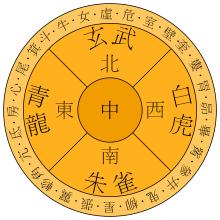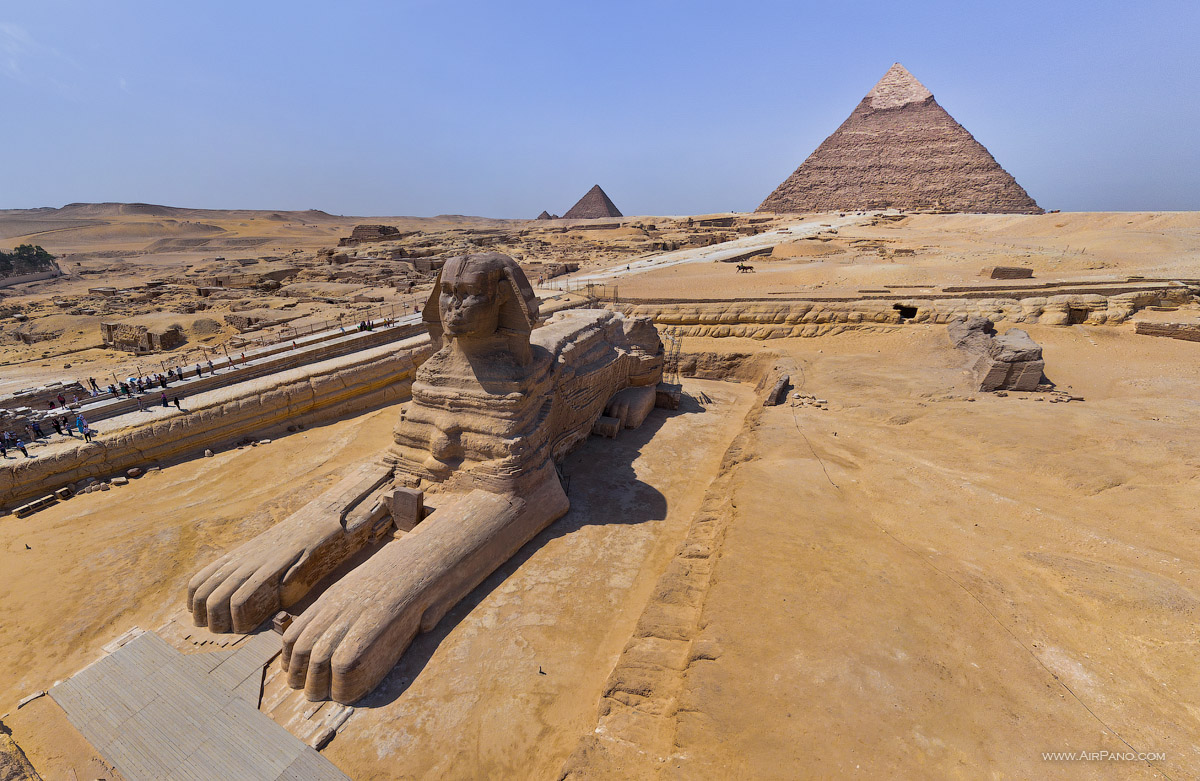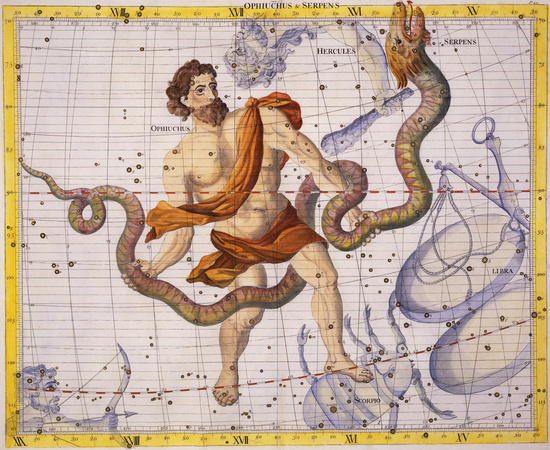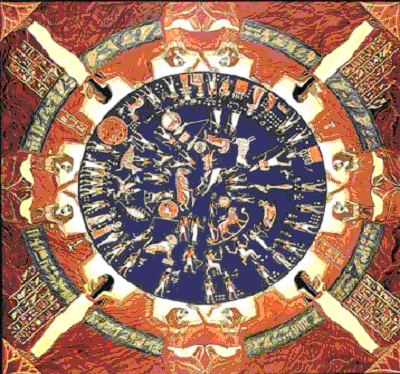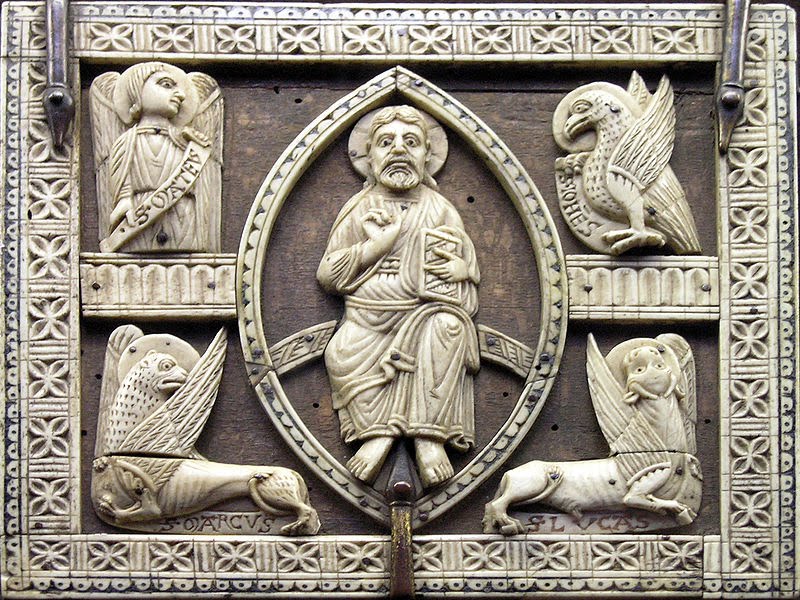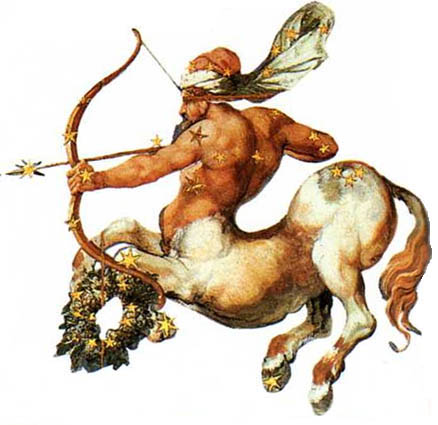
The Great Sphinx in the Dendera Zodiac
The Mystery of the Sphinx and the Celestial Gospel
Scriptural references and ancient sources demonstrate that God called the constellations by their names, opening with Virgo and ending with Leo, and this order is divinely orchestrated, forming the ancient basis of the Gospel in the Stars. The Almighty has ensured the preservation of His Gospel in the Stars not only with the 100+ individual star names, but also with the themes taught by each of the 12 constellations, supported by their decans.
Ps. 147:4-5 4 He telleth the number of the stars; he calleth them all by their names.
5 Great is our Lord, and of great power: his understanding is infinite.
The Scriptures are God’s Revealed Word and absolute standard for truth, and the oldest book in Scriptural canon is the Book of Job, that contains more ancient astronomical references to star names than any other. The truth that God Himself numbered and named the Stars, shows the gravity and emphasis that He placed on His Celestial Gospel, [Isa. 55:8-13]. God did not leave this in the hands of men, but deemed the integrity of the Gospel in the Stars too important to be handled by anyone other than Himself. We can see this as the Almighty questions Job, regarding Who has control over the Heavens.
Job 38:31-33 31 Canst thou bind the sweet influences of Pleiades, or loose the bands of Orion?
32 Canst thou bring forth Mazzaroth in his season? or canst thou guide Arcturus with his sons?33
Knowest thou the ordinances of heaven? Canst thou set the dominion thereof in the earth?
As we have seen in previous blogs the origin and purpose of the Great Sphinx has its roots in astronomy. The stellar function of the Great Sphinx is augmented by the role of the Sphinx as a sighting device, tying directly to one of its astronomical uses, to observe and record the horizon points of the sunrise, as documented by Moses Cotsworth. This aspect of the Sphinx brings new light as taken with its astronomical origins found in the Dendera Zodiac, in Esneh, Egypt.
Figure 1. Enlarged inset graphic of Virgo and Leo originating the Great Sphinx. 3

The inset graphic on the Dendera Zodiac above is from the Esneh Temple, where an image of a Sphinx was put between the signs for Leo (on the lower left) and Virgo (on the right, holding a branch). The word sphinx means “to bind closely together” (from the Greek-Sphiggo), depicting the point where the Mazzaroth/12 constellations begin and end. And, like the female head of the Sphinx, the constellations begin with Virgo, and end in the Sphinx’s lion tail, with Leo. This reveals an astronomical purpose of the Mazzaroth’s divine order in the Great Sphinx that unlocks the age-old mystery of the zodiac, consistent with the themes of the Gospel in the Stars, that would have been taught by Biblical Patriarchs like Seth and Enoch. This is supported by strong ancient traditions in Egyptian Myth, that Enoch holds a key place as the embodiment of Thoth-the god of wisdom, and as the divine scribe–recorded the King’s deeds in his reign. Thoth/
Hermes, and Enoch were all revered in their links to the invention of writing and sacred books. With common celestial roots where-Hermes ostensibly recorded 36,525 books and lived 365.25 years, while Enoch also lived 365 years, [Gen. 5:23] matching the number of days in the solar, or Sothic year. This stands out as an anomaly when all of Enoch’s Patriarchal counterparts had life spans in excess of 895 years with the exception of Lamech who lived 777 years. In later Judeo-Christian lore, descendants of Seth including Enoch were credited with planning and building two pillars, one of which coincides with the Great Pyramid of Giza, and perhaps the Great Sphinx, encoded with prophetic wisdom “in the Siriadic land,” referring to Egypt, the land of Sirius.
Amazingly, the dimensions of the Great Pyramid also support this idea because; “the ratio of the Pyramid’s base perimeter to its height is none other than twice the quantity of pi. In other words, the Great Pyramid’s height is to its base perimeter as a circle’s radius is to its circumference. Using the Sacred cubit measurement, every one of the Pyramid’s basic external and internal measures can thus be expressed as a function of the quantities pi and 365.242. The Great Pyramid’s extraordinary geometry not only combines all the above data into a single elegant identification of the planet upon which we live, but it also gives these quantities durable expression in terms of themselves.”4
If my goal was to depict Enoch’s role in the design and building of the Great Pyramid, what better way is there to link Enoch’s out of place, signature life span of 365 years to the design of the Great Pyramid, in the absence of a complete written record?
The larger image above is from the Dendera zodiac taken from the ceiling of a Portico dedicated to Osiris in the temple of Hathor in Dendera, Egypt. “An indication of the antiquity of this temple site is given by the astronomical alignment of the main temple to Gamma Draconis before 5000BC. Early texts refer to a Pre-dynastic temple that was rebuilt during the Old Kingdom, and further developed by New Kingdom pharaohs including Thutmose III, Amenhotep III, and Ramses II and III. The present structure dates to the Greek and Roman periods, with the sanctuary and its surrounding chapels built by the later Ptolemies in the 1st century BC.”5
The 12 main constellations are highlighted and labeled. This bas-relief is dated variously from 5000+ BC to 50 BC, and is currently displayed at the Louvre in Paris. Since orthodox archaeology only dates the Sphinx back to the 4th Dynasty reign of Pharaoh Khufu–whose face they hold is that of the Sphinx, their dating of the Great Sphinx goes back to his reign around 4600 years ago. This theory rests on scant real evidence, and Khufu’s face on the Great Sphinx rests on little beyond conjecture. There is more solid scientific archaeological and geological evidence based on water erosion, dating the Great Sphinx to at least 7,000 BC. Geologists agree that ancient Egypt faced a great flood that has done much damage to the exterior of the Great Sphinx. Other than the evidence presented here; [Job 19:23-25], there are no known ancient written historical records that mention the Great Sphinx, or its carving, so the astronomical purpose for the Great Sphinx, as seen in the Dendera zodiac is the most solid evidence that has yet surfaced. This being the case, it deserves much more attention than has been paid by orthodox archaeology, who have given these records the silent treatment for decades if not centuries.
Not only does the Great Sphinx provide the divine order of the Mazzaroth as the Gospel in the Stars, but it also prophecies of the Birth of Christ with multiple celestial signs that occurred in Leo, the body of the Sphinx, as the Sunset in Virgo, the Sphinx’s head, on 9-11-3 BC. The unique crowning of the female head of the Sphinx is found in Figure 1 with a solar disc on Virgo’s head, as Virgo was clothed with the Sun, and the moon at her feet; [Rev. 12:1-2]. This ancient solar association with the Great Sphinx was later corrupted in Egypt in the veneration of the Sun god-Ra.
The first dawn appearance of Leo at summer solstice would have signified to ancient observers circa 3000-2000 BC the opening of Nile Flood season. Since the star Sirius would be making its first dawn rising –known as it’s Heliacal Rising– at the same time, then the signal would be interpreted metaphorically as the sun entering or joining Leo in the horizon and the start of the Nile Floods, when also Sirius first became visible.
Figure 2. The Great Sphinx facing Leo at Sunrise on the Summer Solstice. 6

Graham Hancock explains in Heaven’s Mirror that, “computer simulations show that in 10,500 BC the constellation of Leo housed the sun on the spring equinox – i.e. an hour before dawn in that epoch Leo would have reclined due east along the horizon in the place where the sun would soon rise. This means that the lion-bodied Sphinx, with its due-east orientation, would have gazed directly on that morning at the one constellation in the sky that might reasonably be regarded as its own celestial counterpart. 7
The pre-dynastic stellar role of the Great Sphinx as a sighting device linked to its astronomical functions, to observe and record the horizon points of the sunrise, found not only in the Sphinx’ orientation facing due east, but also in relation to the tropics of Cancer and Capricorn. Later in the Old Kingdom, it became the focus of the idolatrous solar cult of the Sun-god Ra, centered in the adjoining temples built after the time the Sphinx‘ was carved out of a local rock cliff.
The Sphinx’s solar alignments relating to the borders of the tropics, depict ancient knowledge of the zodiacal band, within which the heavenly bodies named by the Creator [Ps. 147:4, Gen. 37:9-11, Isa. 40:26, Job 9:7], shed their 3-fold light upon the Earth. God set the tropics of Cancer and Capricorn, as boundaries within which the Sun, Moon and Planets all move, above and below the celestial Equator.
Ps. 147:4; He telleth the number of the stars; he calleth them all by their names.
By marking the tropical borders, we see another way where the Great Sphinx enlightens the world via the heavenly bodies of the celestial gospel, within the zodiacal band. The Biblical Patriarchs would have recognized that the tropical borders set the general parameters within which the light of God’s Gospel in the stars was revealed upon the Earth. This celestial pathway of 14 degrees (the zodiacal band) separates the planets and stars outside this band, unnamed by God in the heavens, from those within this band whose names have been with us since antiquity. It also determines the boundaries of the tropics of Cancer and Capricorn, presently 23 degrees and 27 minutes north and south of the Equator.
Of the countless lights in the firmament, God set those inside the path of the zodiacal band apart, to carry His sacred message in the celestial gospel. This is where we find the majority of ancient 48-star pictures, named by God, with the exception of the circumpolar stars. In this way the borders of the zodiacal band are seen as celestial reflections of the terrestrial tropical boundaries, outlining the Latitudes in which heaven’s threefold light is shed upon the Earth. This also provides a standard where we can separate the genuine 48 named signs and decans, from those that have been added by man. This also explains the importance of God numbering the Stars, because He did not include the stars outside the zodiacal band in His sacred message of the Gospel in the Stars. This contradicts one of Faulkner’s assumptions, that God named all the Stars, as He only named certain stars within the tropical boundaries to carry the themes of His Gospel in the Stars.
Bullinger differentiates the “almost infinite distance between the ancient stars named by God, and the more modern named by man. The stars named by God are full of mysterious significance and grandeur, while the secular names are puerile in the extreme, bordering on the comical! For example; the Air pump, Painter’s Easel, Telescope, the Triangle, the Fly, the Indian, Microscope, Fox and Goose, the Balloon, Toucan, the compasses, Charle’s Oak, the Cat, the Clock, etc. Bullinger points out that 22 new constellations were added by Hevelius [1611-1687] and another 15 by Halley, of Halley’s Comet fame, [1656-1742].” 8
These stars named by the Almighty serve the function of the Great Sphinx’ Alpha/Omega signs of the Mazzaroth; Virgo and Leo, whose godly purpose is readily evident, having nothing to do with the stars randomly named by man. In building the Great Sphinx’s adjoining temple, quarried stone blocks of over 200 tons were used, with some of this Sphinx temple masonry matching stone-work in building the Pyramids. This includes the causeway connecting the Pyramids to the Great Sphinx, showing the linkage between these uniquely historic monuments on a number of levels. It is logical that some of the quarried blocks were used to construct the temple, as the Sphinx was being carved out of near-by existing rock. It also suggests a master-plan for the blueprints to build these elements of the Giza Plateau including the Sphinx, its temples and the Pyramids. The concept of a master-plan for the Giza Plateau is one that will be developed as our narrative proceeds in a future blog on the history of these monuments of ancient Egypt.
With the exception of a few die-hards, most egyptologists consent to the accumulating body of archaeological and geological evidence, indicating that the Sphinx dates much older than the 4th Dynasty, and that the Sphinx was only restored by Chephren, not built during his reign. Added evidence from the ‘Inventory Stele‘ uncovered near the Sphinx in the 19th century relates that Pharaoh Cheops/Khufu, Chephren’s predecessor – ordered a temple built beside the Sphinx, meaning the Sphinx already existed at this earlier time, and thus was not built by Chephren. Since the astronomical elements of the Dendera Zodiac that inspired the Great Sphinx must predate it, we can see how the ages of the Dendera Zodiac and the Great Sphinx are inseparably joined, giving us a truer idea for the ages of these monumentally intertwined ancient artifacts.

The Inventory Stela provides strong evidence, by Khufu himself, that he was not the builder of the Great Pyramid, and that the Pyramid and Sphinx, already existed during his reign. Egyptologists
like James H. Breasted, included the Inventory Stela in his official list of Fourth Dynasty artifacts, stating that it “bore all the marks of authenticity.” Also, the French Egyptologist Gaston Maspero whose well-known work, “The Dawn of Civilization,” stated that the stela was indeed a factual record of the life and deeds of Khufu. 9
A main reason why orthodox archaeology may not be too keen on this ancient astronomical evidence for the Great Sphinx, is that it undermines their theory of the origins and builders of the Sphinx, not to mention the other elements of the Giza Plateau. Obviously, if the origins of the Sphinx are based upon the evidence seen in the Dendera Zodiac, it washes out the cherished theory that the Sphinx was built by the Pharaoh’s Khufu/Kapfre, that already appears the case resulting of the Inventory Stela evidence. However, these links between Dendera Zodiac and the Sphinx could increase the potential age of both of these historic pieces, with the Great Sphinx being the older of the two.
This Astronomical evidence for the age of the Great Sphinx has been denied a voice at this writing, which has also had a detrimental effect on the witness of a Gospel in the Stars, supported by the divine order of the constellations starting with Virgo, ending with Leo the Lion, which embody the thematic Gospel in the Stars. The 10 constellations between these Alpha and Omega signs along with the 36 decans, complete the 48 signs that convey the gospel message. The Figure 1 image of the inset graphic, comes from the Square Dendera zodiac in the Temple of Esneh seen below, where we find images of Virgo and Leo with the Sphinx between them on the left side of the zodiac.
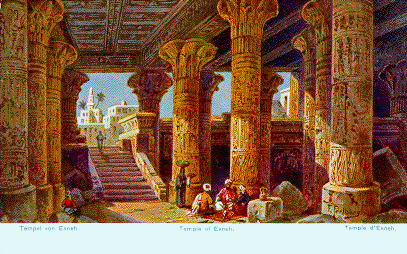
Figure 3. Square Dendera zodiac from the Temple of Esneh. 11

The image of the Great Sphinx is derived from the left side of this square zodiac shows Virgo and the Sphinx in the lower rectangle and Leo the Lion in the upper rectangle. We have focused on this enlarged image above, where the Sphinx image between Virgo and Leo is crowned with an Egyptian Solar Disc, perhaps indicating the Sun in Leo.
In his critique of Frances Rolleston’s book The Mazzaroth, Faulkner [2013] referring to the origin of the knowledge of the 12 signs of the zodiac in relation to the “Gospel in the Stars” states; “The
dominant belief is that they originated with the ancient Babylonians (not the neo-Babylonian empire). From the Babylonian’s the constellations were transmitted to the Egyptians, and the Egyptians in-turn passed them on to the Ancient Greeks, although there may have been some direct transmission from the Babylonians to the Greeks.” 12
Figure 4. The 12 Signs of the Zodiac from the Dendera Zodiac

So Faulkner recognizes the deep antiquity of astronomy in ancient Egypt, but puts no credence, or has not fully considered historical evidence of an Egyptian basis for the Gospel in the Stars. Since we have established a firm basis of Messianic Prophecy from various ancient Egyptian artifacts, and archaeo-astronomical practices, all far predating the publication of Rolleston’s book, most of his arguments fall by the wayside against the precedent of a “Gospel in the Stars.” As we have shown, from many authoritative sources, the roots of the Dendera Zodiac and their depiction of the 12 signs of the zodiac, date back to at least the 3rd Millennium BC, if not earlier. This includes their system of decans, with Egyptian star names that in many cases match gospel themes taught in Biblical Astronomy. We have also shown how elements of the Pyramids on the Giza Plateau, for example how the Great Pyramid is a “sign” [Isa. 19:19-20, Gen. 1:14] and witness to the Lord of Hosts in the land of Egypt,” The Hebrew word for sign here is the same word used in Gen. 1:14, referring to the “lights in the firmament of heaven” like the Celestial Gospel among other applications. This Hebrew word [Owth–H226] also used in Isa. 7:11 tells us these signs can be seen “in the height above.” This word indicates a present visible token or pledge, as a promise from God, 13 and it occurs again in Isa. 7:14 in reference to the virgin conception and birth of Christ.
This reference to the Star of Bethlehem, not only refers to the event of Christ’s Birth, but also the astronomical markers and signs pointing to this birth of the Ages. The Dendera Zodiac also prophesies of the Birth of Christ, not only with the intersection of Axis “E” with Virgo, on the Dendera Zodiac, but also with its decan Coma, detailed below.
Figure 5. The 5th Axis of the Dendera Zodiac thru Spica-Virgo and Pisces.
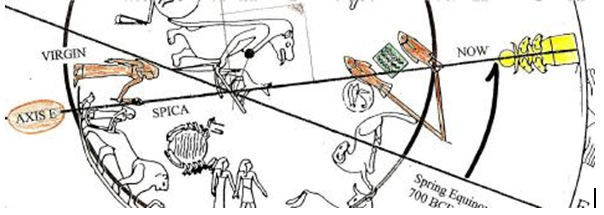
Christopher Lash relates his perspective of Dendera’s axes as follows:
“As I studied the overall design of the zodiac I realized there was a 5th, as yet undetected axis. My attention was first drawn to its presence by the figure of Virgo the grain goddess identified with Isis, who holds up a stalk of wheat in a gesture known from Sumerian sources as early as the 3rd millenium BC.” It extends from Spica, the star in the hand of the Virgin, through the center of the Dendera Zodiac [jackal’s paw], to the Ram-headed altar on the periphery, neatly bisecting the altar. 14
We should recognize Virgo’s wheat stalk as her brightest star, known today as Spica, but in the Hebrew as [Al Zemach] meaning the branch, is one of the prominent titles of the Promised Seed, or offspring of God, in the Old Testament [Jer 23:5-6]. This also shows how the star name of “Spica” not only is used in the Bible, but also how it occurs on the Dendera Zodiac, a direct contradiction of one of Faulkner’s “assumptions,” [more on this later].
Figure 6. The Round Dendera Zodiac showing Axis E alignment of Spica with Coma.

When Axis “E” in Fig. 5, is extended below Spica held by Virgo, it intersects the Decan Coma, seen in dark Blue, in Fig. 6, where the Coma Supernova shined brightly for about 275 years in the head of the child in Coma’s lap, before and after Christ’s birth. The status of this new star as a supernova in Coma, referenced by Archbishop Trench who said; “This star I conceive, as so many ancients and moderns have done, to have been a new star in the heavens.” 15
The Real Riddle of the Sphinx
The true riddle of the Sphinx is that it binds together the first sign in the zodiac with the last sign in the zodiac, and gives us the correct beginning of the year according to the divine order of the twelve constellations. This understanding sheds new light to see Virgo (the Virgin) as the first sign (and the 1st coming of the Messiah), and Leo (the Lion) as the second coming of the Messiah (the Lion of Judah), at the end of the age.
This Zodiac marker of the Alpha and Omega points of the start and finish of the 12 signs of the Zodiac or the Mazzaroth, also gives us the proper narrative of the Gospel in the Stars, starting with Christ’s Birth and first appearance on Earth, as seen in VIRGO. I have included the Fig. 1 image of the Dendera Zodiac for a number of reasons, first due to the teaching of the Great Sphinx that I have advocated for over 25 years. Secondly, due to errors on this Dendera Zodiac by those who highlighted the 12 signs which is readily visible, by comparing the Inset graphic in Figure 1, with the Dendera Zodiac itself. This inset image correctly shows Virgo holding her stalk of Grain right behind the lion, standing on the right side of this graphic. However, this does not match the actual image for Virgo on the Dendera Zodiac above. We can plainly see the standing image of Virgo not highlighted, but in her correct position between Leo and Libra, seen as the familiar scales of balance. We find this partially obstructed image [blocked by the inset graphic] of a standing woman carrying her grain stalk, behind Leo the Lion, but the image actually labeled as Virgo is found seated below the Lion, not holding a Grain stalk but a standing infant, in her lap. In Egypt they called him Shesnu-the desired Son, [Hag. 2:7]. Just as the woman in Virgo is identified with the woman in Coma holding and nourishing her promised Seed, the desired Son who in Greek is called Christos. 16
This is a notable, if fortuitous error since the sign labeled as Virgo is actually an ancient decan of Virgo called Coma, matching the Decan image from the Dendera Zodiac, as seen below. Another error of mislabeled signs on this graphic of the Dendera zodiac concerns Pisces, which is marked as “Libra.” There are two other decans of Virgo, the 1st being a Centaur–a mythical combination of man and horse, depicting the dual nature of Christ coming in his sufferings, laying down his life in perfect sacrifice for all mankind. And second, in glory with his victorious return and final defeat-crushing the serpent under his feet once and for all. The 3rd Decan of Virgo is called Bootes by the Greeks, from the Hebrew root “Bo” which means coming, again referring to Christ coming. The brightest star in Bootes is called Arcturus, [Job 38:32] above, meaning the guardian or Shepherd of the flock or Sheepfold, kept in the enclosures [Ursa Major and Minor, Job 9:9], where the blessed sons and daughters of God enjoy their everlasting fellowship with the Heavenly Father in Christ. 17
This exposes a blatant error where Faulkner states; “Since no names of individual stars are in the Bible, the idea that God shared any of His names for the stars with man must necessarily be extra-biblical.” Yet as we have just shown the star Arcturus is specifically named in Job 38:32, among others, like Spica and Coma. Faulkner, after much discussion on the meaning of the Hebrew word rendered Arcturus here, despite some slight disagreement on the meaning of this star and those of Ursa Major and Minor, the sheepfolds mentioned above, the fact remains that this is one of multiple examples of specific stars being named in the Bible. Of course his reference to “extra-Biblical sources” thus does not refer to star names, or monuments like the Sphinx or the Great Pyramid since these are both referred to in Job, and Isa. 19 refers to the Great Pyramid also. Obviously, we won’t overlook the Dendera Zodiac, as so many have already done to their harm, missing the historical significance of a unique written record of Great Sphinx, covered for so long due to Archaeological hubris and ignorance.
Figure 7. The Decan of Virgo called Coma from the Dendera Zodiac 18
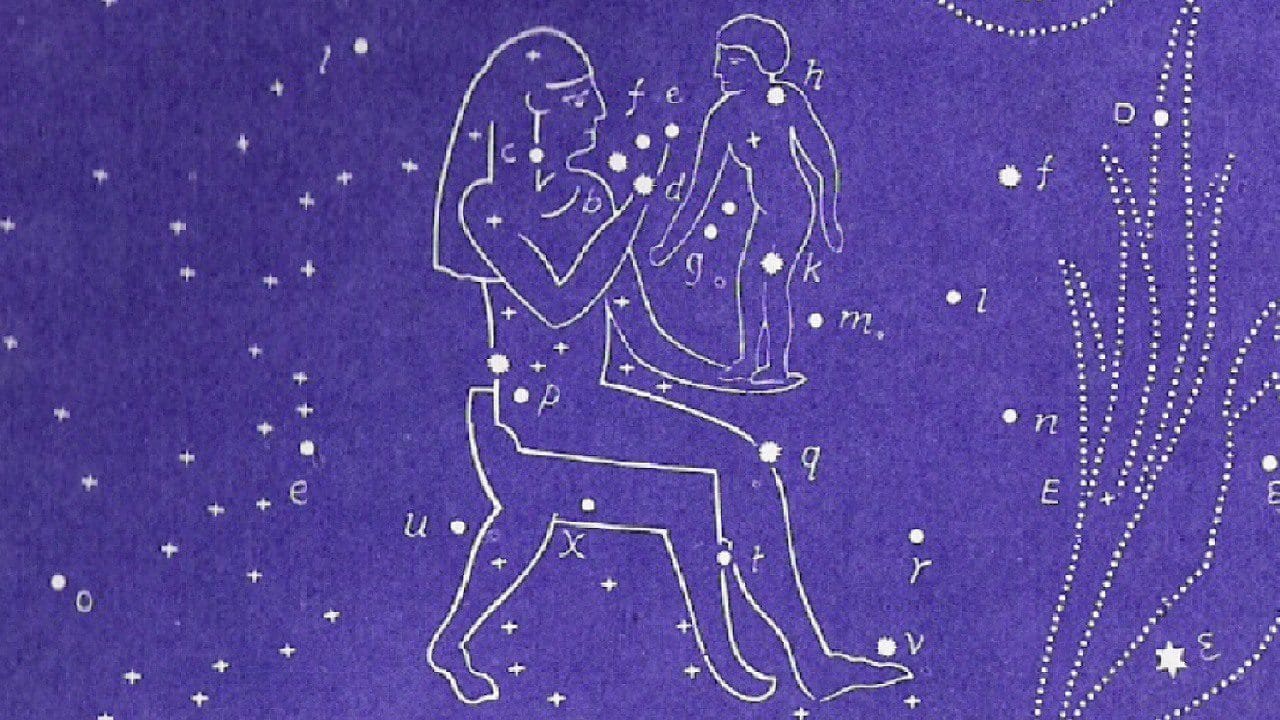
In the late 90’s I began teaching the General Sign of the Celestial Prelude, as a supernova that exploded in the head of the infant of the decan Coma. This is the initial clue as to what the Magi were prompted to look for, not a comet, like Halley’s Comet that some have attempted to make a case for. The dates for Halley’s Comet are too early, to coincide with the birth of Christ, although it does fall within the timeframe of the General Sign of the Celestial Prelude, about 5 years before the triple union of Jupiter-Saturn in 7-6 BC. The foregoing and concurrent supernova in Coma was designed to draw the Magi’s attention to this general time frame of the birth of the promised seed, so they would recognize the true signs of the Star of Bethlehem when they took place in 3-2 BC.
In his critique of the Gospel in the Stars, Faulkner continues against the writings of Joseph Seiss;
“If one uncritically reads what Seiss wrote here about decans, it is convincing. However, once one realizes that there is no basis for the decanal arrangements as put forth by Gospel in the stars advocates, then the quotes do not amount to much. That is, one could easily understand these quotes in the context of the proper view of the decans being 10-degree increments within each zodiacal sign.”19 As I have provided this organized and historical view of the ancient Egyptian structure of their decans in 10 degree increments, going back to at least 3,000 BC, it appears Seiss’ case for the decans would remain a convincing one. In fact, Seiss concludes his discussion of the decans with this interesting sentence:
And after the closest scrutiny, those who have most thoroughly examined and mastered the subject in its various relations entirely agree with the same enumeration, which I therefore accept and adopt for the present inquiries into this starry lore, sure that the particular examination of each sign, with the Decans thus assigned to it, will furnish ample internal proof that this enumeration is correct according to the original intention. 20
Here Seiss appeals to self-consistency for ultimate proof of the arrangement. That is, the 3 other decans supposedly linked with the 12 zodiacal signs complement each other so well as to depict that the arrangement is true. Faulkner adds: “I cannot find a precedent for her decans in literature, and this arrangement appears to be unique to the gospel in the stars, suggesting that this arrangement originated with Rolleston. If anyone can produce a clear reference from Albamazar or from any other ancient or medieval source of the arrangement presented by Rolleston thus showing that her arrangement of the decans predated her, then I will gladly withdraw this.”21 [Faulkner 2013]
Obviously, with all the evidence we are presenting from Ancient Egyptian astronomy, we are taking up Faulkner’s challenge directly, of “producing a clear reference from any other ancient source that these decans” 22 notably predated her writings, and that he should withdraw his criticism of Rolleston, on these grounds.
Unlike Seiss, we are not relying exclusively on the internal self-consistency of the ancient meanings of the decans as they support the themes of the 12 main constellations, even though we do not deny the existence of this element of the Gospel in the Stars, and we have documented it in the agreement between the decans of Leo with Leo the lion. But we will point out Faulkner’s errors specifically with the decan of Coma that led him to false conclusions. As Faulkner points out regarding the Decan of Coma, he picks up its history starting with the nomenclature of the Coma Berenices decan seen as the hair of Queen Berenice II of Alexandria. Citing the Queen’s death in 221 BC, Faulkner concludes the constellation cannot date any earlier than that. 23 His summary obviates any link to the Coma Decan in the Dendera Zodiac, along with its potential 5000+ year history.
Figure 8. Virgo “clothed with the Sun with the Moon at her feet” on 9-11-3 BC, with the decan Coma “Berenices” pictured according to Greek Myth as a woman’s wig
![]()
References to this being the hair of Queen Berenice began appearing within a century after her death, and Ptolemy mentioned this faint grouping of stars as hair, but did not ascribe it to her. Faulkner does recognize how both Seiss and Bullinger identified Coma on the Dendera zodiac, but Faulkner says that “later cultures misunderstood this.”24 Faulkner stays on his critique by noting her reference to the Coma Decan on the Dendera zodiac;
In our previous blog from April 2020, we presented historical evidence of how the ancient Egyptians documented and calculated their stellar decans in their rich history of heliacal rising of stars.
Rolleston (1865, part 2, p. 16) noted that on the Dendera planisphere there is a figure of a woman holding a small child below the figure of Virgo, and she surmised that this otherwise separate drawing was related to Virgo, though Virgo has no child displayed with her. Rolleston (1865, part 2, p. 17) posited that Coma represented the branch or sheaf of grain that Virgo normally is depicting as holding. 25
I agree with Rolleston’s assertation that “Coma represented the branch or sheaf of grain that Virgo normally is depicting as holding,” for a number of reasons primarily because it agrees chiefly with the Scriptural witness of the star Spica as the Branch, as seen below. Since Faulkner has given no practical credence to the witness and powerful influence of the Dendera Zodiac or the Great Sphinx, he makes the mistake of ignoring this rich Egyptian astronomical history of the 12 signs supported by the decans, and acknowledges only the Greek history of the Coma Berenices decan, asserting that; this constellation cannot date earlier than Queen Berenice’s death in 221 BC! With one breath he acknowledges the ancient Egyptian history of the constellations, including the Coma Decan, but in the next breath, wipes it away as if it never existed, cutting it off beyond the Greek history of Coma Berenices.
As shown in Faulkner’s quote of Seiss; “The Greeks knew not how to translate it, [Coma] and hence took Coma in the sense of their own language, and called it hair—Berenice’s Hair (Seiss 1882,
p. 29).26 The Greek word for hair is Co’me, which in Latin was Coma, so the original meaning of the decan Coma on the Dendera Zodiac, linked to Virgo’s branch of grain, was corrupted in the Greek translation. 21 The original connotation in the Dendera Zodiac is found in how the Coma decan supports the gospel message being conveyed in Virgo, as seen in the brightest star in Virgo known as Spica.
Virgo is always portrayed holding a spike of wheat in one hand and a staff. The spike of wheat fits, the star Spica (alpha star of Virgo ), as one of the oldest star names in use (and the origin of “spike-” the English word for an ear of grain). Virgo is the 2nd largest constellation and the Sun stays longer in Virgo than in any other constellation of the zodiac, entering on Sept. 21 and not leaving until November 1. The Sun is therefore within its boundaries at the time of the autumnal equinox, about Sept. 23.
Figure 9. Virgo at Sunset on Sept. 11th, 3 BC.
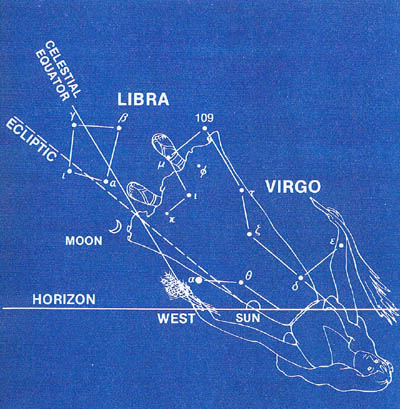
The sign Virgo emphasizes her fertility or motherhood, as she holds in her right hand a branch, or staff, also a title applied to the Messiah as the offspring of David, and in her left hand some sheaves of corn, or seeds of wheat (ear of grain, spike of wheat (Spica).
The star Spica, in Virgo, which appears to be only one of two specific stars shown on Dendera’s zodiac, the other being Sirius, embodies the Promised Seed-Jesus Christ in a four-fold ministry as King, Son of Man, Servant and Son of God, as seen in the Four Gospels; Matthew, Mark, Luke and John. This is also found in OT Messianic Prophecies listed below, showing how the Gospel in the Stars supports God’s Written Word concerning Jesus Christ. The Branch is the Biblical name for the Star-Spica in the Old Testament, as the name of the coming Messiah.
1. Matt.-King of Righteousness [“Kingdom” referred to in Matthew more than any-where else] [*Zech. 9:9, Jer. 23:4-6, 33:15] Thus the royal genealogy is in Matt. 1:1-17]. “Kingdom of Heaven” is only in Matthew, none of the other gospels.
Jeremiah 23:4-6 “…the days come, saith the LORD, that I will raise in David a righteous Branch, and a King shall reign and prosper, and shall execute judgment and justice in the earth…Judah shall be saved, and Israel shall dwell safely: ..he shall be called, THE LORD OUR RIGHTEOUSNESS.” This Branch is the same as that in Isaiah 4:2.
Jeremiah 33:14-16 “…I have promised unto the house of Israel and to the house of Judah…
will I cause the Branch of righteousness to grow up unto David; and he shall execute judgment and righteousness in the land…Jerusalem shall dwell safely…
2. Mark–Servant of Jehovah [“Lord” 3x here, 78x in the other 3 gospels] [Isa. 42:1, Zech. 3:8] Thus No genealogy is given in Mark. Zechariah 3:8 “…I will bring forth my servant the BRANCH.”
3. Luke– Son of Man [Luke records his childhood, his dealings with women, publicans and other key aspects showing his humanity] [Zech. 6:12, thus the human genealogy is given going back to Adam, (Lk. 3:23-38)] Zechariah 6:12 “Behold the man whose name is the BRANCH.”
This Branch is the same as that in Isaiah 4:2, but here “my servant,” identifies the character is the title of Messiah (Isa. 4:2, 42:3, 50:10, 52:13, 53:11, Ezek. 34:23-24) and the Messiah, a tender branch from the almost extinct royal line of David (Zech. 6:12, Isa. 4:2, 11:1, Jer. 23:5, 33:15).
4. John– Son of God [Zech. 4:2][“father”-121x, only 66 times in the other 3 gospels.
“My Father”-35x only 18x in the other 3 gospels, “only begotten” 4x, none in other gospels]
The purpose of every chapter in John’s Gospel reveals Christ’s true identity.
“Son of God” in the Gospel of John–
John 1:14-18: only begotten Son
John 1:34-36 Son of God & Lamb of God
v. 41-Messiah
v. 49-RABBI, King of Israel
Isaiah 4:2 “In that day shall the branch of the LORD be beautiful and glorious.”
In Isa. 4:2, Sanctification is promised by means of a branch, or Heb. tsemach, tseh’-makh, from Heb. tsamach, tsaw-makh’, a primary root, to sprout, thus meaning a sprout. lit. or fig.: – branch, bud, that which grew, spring. This branch was the sprout of Jehovah. Messiah as in (Jer. 23:5, 33:15, Zech. 8:8, 6:12, and Luke 1:78).
Micah 5:1 “rod” (judge), and Psalm 2:9 “rod of iron,” denoting severity as in Rev. 2:27.
Isaiah 11:1 “And there shall come forth a rod out of the stem of Jesse, and a Branch shall grow out of his roots:
Isaiah 11:2 And the spirit of the LORD shall rest upon him, the spirit of wisdom and understanding, the spirit of counsel and might, the spirit of knowledge and of the fear of the LORD;…”
The manifestations of the Spirit in the OT.
Rod – Heb. choter, kho’-ter, from an unused root, a twig, rod, or as other sources state it as Heb. maqqel, matteh, shevel, also Gr. rhabdos, rhab’-dos, a stick or wand, rod, sceptre, staff as seen in Rev. 2:27 represented the coming of Christ who was to be preceded by the rod as seen in Micah 5:1. Jesus embodies the rod or (scepter-Psalm 2:9). Others believe that Isa. 11:1 refers to a humble rod which shall come out of Jesse (as the Messiah).
This panoramic view of the Star Spica in Virgo shows how God’s Word elaborates on what this star really embodies, and why it was only one of two stars so emphasized on the Dendera zodiac, that so beautifully fortells of the birth of the Promised seed in the early Piscean Age.
I’m so thankful for our Heavenly Father who sent His Word to us whether spoken, in Creation, Written or in the Flesh, they all embody the Promised Seed- Jesus Christ, the Anchor of our souls, in whom we continually abide day by day unto the Coming of that Great Day!
God Bless!
Rene’
Footnotes
1. [http://yin.interaccess.com/~jas/5.shtml]
2. December 1, 2012 Asec
3. From The Alpha and the Omega – Chapter 1, Jim A. Cornwell, 1995.
4. Decoding the Great Pyramid, Lemesurier p. 12
5. [https://sacredsites.com/africa/egypt/dendera.html]
6. http://myblog.robertbauval.co.uk/
7. Heaven’s Mirror, Graham Hancock & Santha Faiia
8. Witness of the Stars, p. 43, E.W. Bullinger
9. The Dawn of Civilization, Gaston Maspero
10. The Temple of Esneh as found on the “Egyptian Post Card Page” at http://itdsrv1.ul.ie/~bolgerb/pc_egy.html.
11. Figure 3. Picture credit -Dendera Square Zodiac. http://www.voyager.co.nz/~masonpj/zodiac.htm
12. Faulkner 2013. https://answersingenesis.org/astronomy/stars/a-further-examination-of-the-gospel-in-the-stars/
13. Companion Bible, marginal note on Isa. 7:11, E.W. Bullinger
14. The Skies in Memory, John Lash in The Atlantis Blueprint, Wilson & Flem-Ath. p. 171.
15. Witness of the Stars p. 39, E.W. Bullinger
16. Gospel in the Stars, Joseph Seiss, ppg. 28-9
17. IBID, ppg.31-32.
18. IBID, p. 19 picture credit on the Decan Coma.
19. https://answersingenesis.org/astronomy/stars/a-further-examination-of-the-gospel-in-the-stars/
20. IBID,
21. IBID,
22. IBID,
23. IBID,
24. IBID,
25. IBID,
26. IBID,
Comments on Facebook
To those of you interested in commenting on this post please go to our Facebook Group Page
https://www.facebook.com/groups/bibleastr
